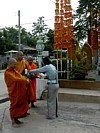|
bintabaat (บิณฑบาต, บิณฑบาตร)
Thai. ‘To beg with an alms bowl’, a word referring to the alms begging round of Buddhist monks, who go around with an
alms bowl (baat) to beg for and
receive food (fig.). Thai mendicant monks are allowed to consume food only before noon and only
that what is offered to them. During bintabaat, the monks and novices walk barefooted in order to make the alms round more of a challenge and an effort, usually starting their round at sunrise (fig.) and returning to the temple in the early morning, since then the soil is then not yet too hot to walk on. However, in
Myanmar, monks and novices can be seen begging in the streets any time before noon, sometimes beating a kyi-zi, i.e. a brass plate gong (fig.), in order to announce their arrival (fig.), akin to the khakkhara, i.e. a beggar's staffs with rattling rings (fig.) formerly used in some Mahayana Buddhist countries. The kyi-zi (fig.) is typically hit three times in succession, as a symbol of the Trairat. Whereas monks and novices go out to beg for food on a daily basis and receive
cooked rice (fig.) and ready to eat meals, Burmese nuns,
recognizable from their overall pink or sometimes beige robes (fig.), only beg for food twice a week, though throughout the day, including in the afternoon, and are given only uncooked rice
(fig.) and foodstuffs, which they must prepare themselves at their nunneries. On some days and previously also in the rainy season, monks may stay at the temple and people will bring food offerings to them, originally in tiab, i.e. a conical food container (fig.) produced especially for offering food to monks and still an extremely popular item in Myanmar today. In Thailand, at the rear end of a row of monks and novices that are on alms begging round, often one or more young
dek wat, i.e. temple boys (fig.), can be seen helping carry the surplus of collected food offerings, which will be taken from the alms bowl and gathered in bags or even a small pushcart at the bag of the row. Offering food to monks is in Thai called
tak baat (fig.) and is a popular way for lay people to make merit (boon).
Though monks are officially not allowed to collect more food than to the rim of their alms bowl, if offered more, they will usually still accept it, as it is considered far better to allow the lay people to make merit by offering the food, even if it will not be consumed, than to not accept it and and thus deny them to gain merit. At the temple, the gathered food will be redistributed to all monks and novices, starting with the most senior ones, as well as to the temple boys and anyone in need of food, including dogs, cats or other animals living on a temple compound, and if any excess of food is still left, it will be dumped as garbage.
WATCH
VIDEO.
回






|

